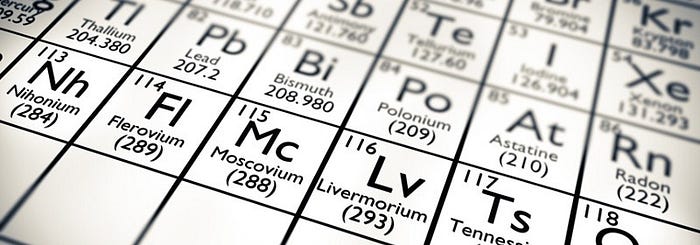The Quest for the Ultimate Element: Discovering the Limits of Atoms
Written on
The Search for the Final Element
In the early 1800s, Johann Wolfgang Dobereiner, a groundbreaking chemist, observed a recurring pattern in the chemical properties of elements arranged by increasing atomic mass. He noted that groups such as halogens, alkaline metals, and alkaline earths consistently appeared in the same order. Following Dobereiner’s discovery, another influential chemist, Dmitri Mendeleev, compiled a table of the sixty-one known elements, which laid the foundation for modern chemistry. This organization revealed gaps where undiscovered elements should exist, enabling Mendeleev to forecast their existence. In 1871, he further refined this chart by aligning elements with similar chemical characteristics into vertical columns, forever transforming the field with what we now recognize as the periodic table.
A pressing question arises: if hydrogen is the first element on the periodic table, what could be the heaviest, or final, element? In other words, if hydrogen (element 1) comprises the smallest atoms with minimal protons and electrons, what would the largest atom, with the most protons and electrons, look like? Logically, there must be a maximum size for atoms. The existence of a largest element, beyond which no larger atoms can exist, is not just a theoretical notion; there is a finite amount of matter that can comprise an atom, thus limiting its size.
One significant challenge in this pursuit is that as the nuclear charge increases, the speed of the innermost electrons also escalates, leading to unexpected phenomena. Typically, adding protons to a nucleus increases an atom's mass and density, resulting in a more substantial entity. However, in the case of extremely massive atoms, the forces binding them can become unstable, leading to disintegration through radioactive decay. For instance, heavy elements like nobelium (element 102) and lawrencium (element 103) have notably short lifetimes, with lawrencium-266 having a half-life of merely 11 hours.
As the atomic numbers increase, half-lives for superheavy elements diminish rapidly. For example, the half-life of flerovium (element 114) is just 2.6 seconds, livermorium (element 116) lasts 0.06 seconds, and oganesson (element 118) has a staggering half-life of only 0.002 seconds. In stark contrast, uranium (element 92) is the heaviest element found in significant quantities on Earth, with uranium-238 having a half-life of approximately 4 billion years.
Advancements in particle accelerators, or atom smashers, allow scientists to create new elements by colliding lighter atoms with heavier targets. For instance, labs have successfully combined calcium (element 20) with curium (element 96) to produce livermorium (element 116). Richard Feynman, a renowned physicist, proposed that the last possible element would be feynmanium (element 137) since electrons in the 1s orbital would need to exceed the speed of light, a notion deemed theoretically unachievable.
However, Feynman was mistaken about the specific element. When Pekka Pyykko conducted precise calculations, he determined that element 173, or unseptrium, is the highest atomic number feasible in our universe. His findings indicate that as atomic numbers increase, the likelihood of forming two nuclei decreases significantly, making the existence of atoms beyond element 172 increasingly improbable.
The stability of these superheavy elements declines rapidly as more protons are added to the nucleus. To illustrate, while researchers can produce several atoms of rutherfordium (element 104) per minute, only a few atoms of seaborgium (element 106) are synthesized each hour, and with hassium (element 108), it takes an entire day to generate just a few atoms.
As of now, predictions for the half-lives and decay modes of elements with atomic numbers exceeding 175 remain elusive. Hypothetically, unoctquadium, with an atomic number of 184, is suggested to be so massive that conventional theories cannot accurately describe its electrons, rendering its synthesis virtually impossible.
In the foreseeable future, the quest for superheavy elements will compel chemists to revise the periodic table, potentially expanding it from the current 18-column format to a more comprehensive 32-column representation. Nevertheless, this expansion hinges on humanity's ability to develop more powerful machines capable of producing heavier elements, such as element 121, if it exists. Until then, all elements yet to be synthesized remain speculative.
Element 119 could hold particular significance as it would initiate the eighth period of the periodic table, adding an additional row unless the left-step table proposed by Charles Janet proves to be a more accurate model. This model elucidates the precise order in which electrons fill an atom's energy levels. If the left-step table is adopted, it is plausible that element 121 would commence the eighth period.
Currently, scientists face a scarcity of suitable target materials for generating the next wave of superheavy elements. For instance, to synthesize element 119, researchers require a sufficient supply of einsteinium (element 99), a notoriously challenging element to produce. Alternative strategies, such as using titanium (element 22) or chromium (element 24), are being considered, but these options yield lower chances of successful collisions compared to calcium, necessitating more intense and costly particle beams.
At present, element 118 stands as the final synthesized element. However, this does not imply that other superheavy elements are mere fiction; rather, it indicates that physicists and chemists have yet to synthesize them. The classification of elements from 119 to 172 remains uncertain, as their existence has not been definitively established. Ultimately, the concept of the "final element" will always refer to the most recently synthesized superheavy element, and the true cutoff point may only be revealed with time.

Chapter 1: The Periodic Table and Its Evolution
As chemists continue to investigate, the periodic table’s evolution may lead to groundbreaking discoveries.
The first video provides an introductory overview of HTML, suitable for beginners looking to understand web development fundamentals.
Chapter 2: The Future of Superheavy Elements
The potential for discovering new elements remains high, albeit with significant challenges.
The second video presents a lyric video titled "The Fifth Element" by VEONITY, exploring themes of existence and the universe.